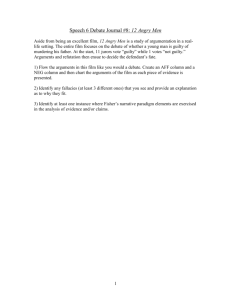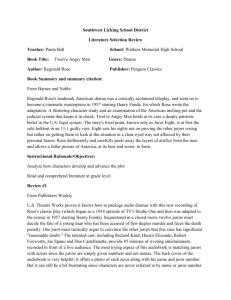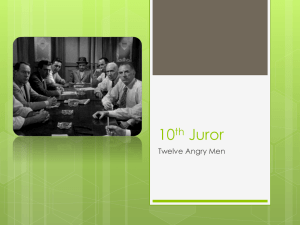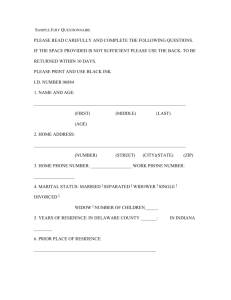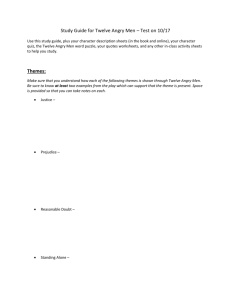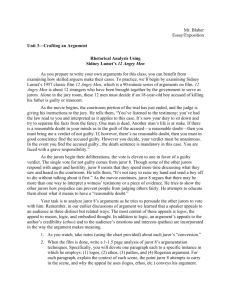Leadership within “12 Angry Men”
advertisement
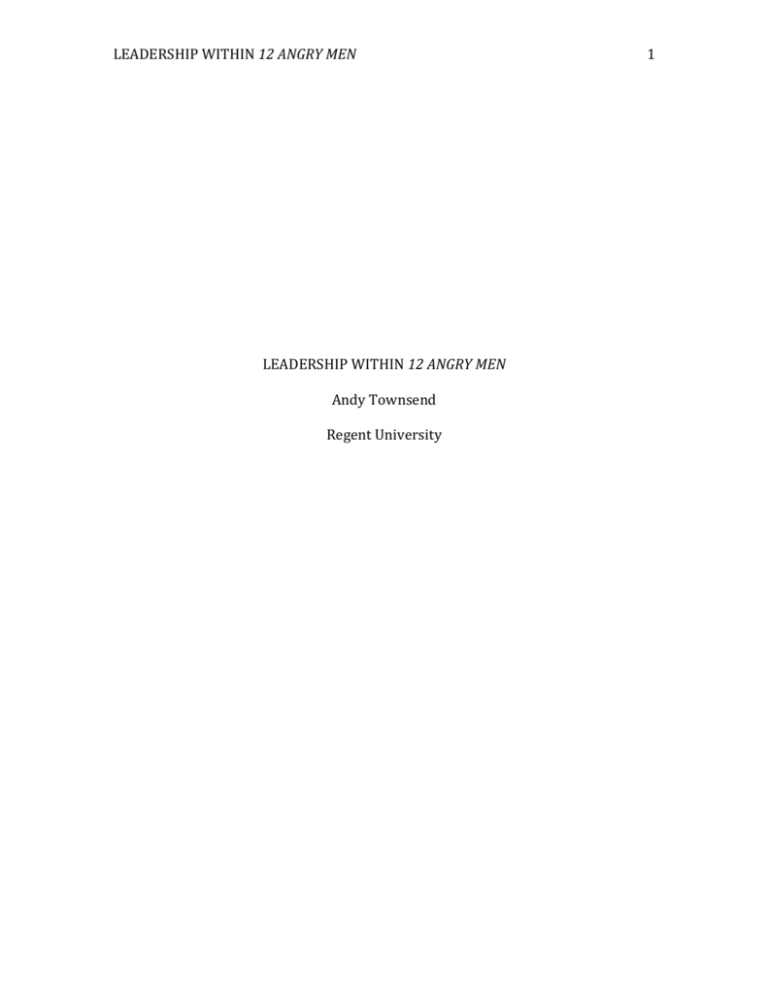
LEADERSHIP WITHIN 12 ANGRY MEN 1 LEADERSHIP WITHIN 12 ANGRY MEN Andy Townsend Regent University LEADERSHIP WITHIN 12 ANGRY MEN 2 THE LEADERSHIP WITHIN 12 ANGRY MEN The 1957 Film, 12 Angry Men, is about a jury on a murder case, with the verdict resulting in a matter of life or death for the accused. They must come up with a verdict for whether the boy is guilty or not for killing his father. The background of the boy on trail shows that he had been brought up in a slum and had a history of violence in the past. The jury is convinced that the boy is guilty, except for one member that sends the group into deliberation to make the ultimate decision of the boys’ fate. Juror number eight, played by Henry Fonda, is the member who stands against the eleven other jurors. He is portrayed as being deviant before he can gain the respect of the other members and emerge as a leader that shines a different prospective into all the other members thought process. This film is and example of becoming a leader, over coming obstacles, conflict and the effectiveness of listening and questioning in a team effort to come up a unanimous decision. At the beginning of the movie all the jurors take a vote without discussion to attempt to come up with a fast verdict. Fonda’s character was the only member of the jury that votes that the defendant is not guilty. In this case Fonda is viewed as being deviant, because he says he doesn’t know whether the defendant is guilty or not, but simply wants to talk about it, and believes that there is reasonable doubt. He also believes that it is ethical to review all the evidence before coming up with a decision that puts the life of the boy into the groups’ hands. The other members want to come up with verdict expeditiously, but the process becomes time-­‐ LEADERSHIP WITHIN 12 ANGRY MEN 3 consuming and causes argument, as Fonda attempts to explain why he feels the boy is not guilty. His deviance is what sends the group into a task process that changes the groups thinking. Deviance is often looked at as being bad, but in some cases like this it can be a good thing. “Dissenting or raising controversial issues can help the team make better decisions and evaluate more options”(Lumsden, Lumsden, & Wiethoff, 2000). Juror number one appears to be the leader of the group; he starts organizing the voting and turn taking. We do not know if he was appointed or not from the beginning, but he lacks experience in leadership. He said he wasn’t going to make rules, and eventually his organization crumbles; he loses control of the group and gives up. This is a display of inadequacy of leadership, because “The leader’s own frustrations and defensiveness may intensify the problems. A person who doesn’t know how to do a job and is afraid to ask for help is not likely to correct inadequacies. As a result, the designated leader may be a leader in name only.” (Lumsden, Lumsden, & Wiethoff, 2000) Fonda stands out from the other members, because he initiates the task process by sharing new ideas and possibilities to the group explaining why the boy is not guilty. He elaborates on what all the other members have to say and makes suggestions to keep the group focused on the task. The other members of the jury had become upset with him, however, after much discussion they start to recognize that he is right and in fact there is reasonable doubt in the case. As the other members are convinced, it opens up the other characters to also provide information and evidence that may prove there is LEADERSHIP WITHIN 12 ANGRY MEN 4 reasonable doubt. Fonda emerges as the leader as he gains the respect of the other members of jury and creates character development. During the process, tension and struggles of power formed. Fonda is constantly in a conflict between jurors three and ten. Both of these jurors had stereotypes and were close-­‐minded to the possibly of the defendant not being guilty. Juror number three was the hardest to convince, he was very aggressive and argumentative to his case, but was also stereotyping the boy because it reminded him of his son. Jurors, three and ten, had a controlling style of conflict, they use bullying when other members gave input against their opinion. However, members like the old man, juror nine, were more open minded and interested in what Fonda had to say. Juror number two, nine and eleven, had a collaborator approach to the conflict. “The collaborator operates from a cooperative, win-­‐win perspective, bringing everyone’s interests and points of view into perspective and trying to ensure that each person’s goals are achieved.”(Lumsden, Lumsden, and Wiethoff, 2000) Jurors seven and twelve, had an accommodator’s approach, which they would rather give in, than to argue about it. The jury was very diverse with characters from all different backgrounds. There was not a good transactional process before the group began the task process. In result of a non-­‐transactional process, some of the conflict emerged because of the things said offended some people. If they took the time before the deliberation to organize a transactional process, then they would have been more familiar with each other’s backgrounds and lifestyles. Thus, they would have been less likely to say something that would offend another member and avoid direct conflict. LEADERSHIP WITHIN 12 ANGRY MEN 5 Emerging, as a leader as Fonda did is no easy task in diverse group, where you know little about the other members. Fonda had to be critical to manage the conflict. The film displays both indirect and direct conflict management. We see Fonda use indirect conflict to suggest new ways of interpreting what the witnesses may have saw and heard when they claimed to have witnessed the boy killing his father. As a direct example, when juror number three offends the juror number nine, the sixth juror stands up to the third juror and directly tells him not to talking to the old man like that to effectively soften his communication. Fonda did a good job of managing the conflict. He remained calm and confident and focused on the task. Ultimately Fonda displayed that it is “important to listen empathically and interactively, to support and confirm each other, to communicate clearly and assertively, and to maintain a cooperative, non-­‐defensive climate”(Lumsden, Lumsden, & Wiethoff, 2000). Listening and questing, undoubtedly played a big part in this movie. In the film the more open-­‐minded jurors began to actively listen to Fonda as he explains why he believes the boy is innocent. As an example, juror eleven brings up the key points that were discussed from the beginning to end, because he was taking notes. Also, the other jurors question themselves as they analyze the information and the examples that Fonda displays. Fonda’s success to convince other members comes from the interactive questioning thought-­‐out the deliberation. Fonda analyzes all the key evidence that was given during the trial. He successfully showed how the women across the street might not have accurately seen the killing because of the train. He also, went through the analysis of how the old man who was a witness LEADERSHIP WITHIN 12 ANGRY MEN 6 could not have made it to the door in time to see the boy, because of this limp and the time it took. By questioning the evidence presented the other members saw other issues in question. As an example, the juror nine spoke up about the women wearing glasses and proved that if she had just woken up when she looked out the window and saw the killing, she most likely did not have her glasses on, therefore would not be able to accurately identify the boy as the killer. Empathic listening comes into play towards the end of the movie when most of the members are convinced that the boy is not guilty, except for juror three and ten. As the team listens to them they understand what these two members are thinking and feeling, unfortunately they feel that their defense is personalized. Juror three is angry because this boy reminds him of his own son, whom he has not spoken to for years, because of a fight they had. Juror ten stereotypes the boy because of his background and how he was raised. The other jurors see this, and understand that they are not making valid points. The two jurors in defense recognize that their points are not ethical or valid and change their answers to “not guilty.” The listening and questioning in the group begins a struggle, but because Fonda was able to keep the members focused, they were able to analyze and develop an understanding to conclude a finial decision of not guilty. Henry Fonda emerged as a successful leader despite the odds against him. He stood for what he believed, remaining confidant and overcoming the conflict. His listening, analyzing and questioning gained the respect of the others. His inspiring point of views allowed other members to open up and provide information that otherwise would be overlooked. This film was a very inspirational movie about not LEADERSHIP WITHIN 12 ANGRY MEN 7 giving in to popular vote. The film depicts almost all the aspects of group communication, from the struggles and conflict to rewarding success of an effective leader. LEADERSHIP WITHIN 12 ANGRY MEN 8 REFERENCES: Avolio, Bruce J., Gardner, William L. Authentic Leadership Development: Getting to the Root of Positive forms of Leadership. The Leadership Quarterly. 2005 PP 315-­‐338 Blanding, Michael.(28 Oct. 2013). Responsible Leadership in an Unforgiving World. Harvard Business School Working Knowledge. Retrieved December 14, 2013, from <http://hbswk.hbs.edu/item/7244.html> Emuwa, Amara. Emerging Leadership Journeys, Volume 6. Issue 1, pp.45-­‐65. Regent University School of Business & Leadership. 2013 Lumsden, Gay, Donald L. Lumsden, and Carolyn Wiethoff. Communicating in groups and teams: sharing leadership. 5 ed. Belmont, CA [u.a.: Wadsworth, 2000. Print. - 8 - Smith, Dr. Anthony. Leadership: The One and Only Path To Becoming a Leader. Leadership now. Retrieved December 14, 2013, from <http://www.leadershipnow.com/anthonysmith.html>
